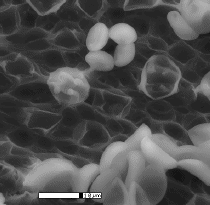



Fungi: Life History and Ecology

This photograph taken using the UCMP
Environmental
Scanning Electron Microscope





This photograph taken using the UCMP
Environmental
Scanning Electron Microscope
As part of their life cycle, fungi produce spores. In this electron micrograph of a mushroom gill, the four spores produced by meiosis (seen in the center of this picture) are carried on a clublike sporangium (visible to the left and right). From these spores, haploid hyphae grow and ramify, and may give rise to asexual sporangia, special hyphae which produce spores without meiosis.
The sexual phase is begun when haploid hyphae from two different fungal organisms meet and fuse. When this occurs, the cytoplasm from the two cells fuses, but the nuclei remain separate and distinct. The single hypha produced by fusion typically has two nuclei per "cell", and is known as a dikaryon, meaning "two nuclei". The dikaryon may live and grow for years, and some are thought to be many centuries old. Eventually, the dikaryon forms sexual sporangia in which the nuclei fuse into one, which then undergoes meiosis to form haploid spores, and the cycle is repeated.
Some fungi, especially the chytrids and zygomycetes, have a life cycle more like that found in many protists. The organism is haploid, and has no diploid phase, except for the sexual sporangium. A number of fungi have lost the capacity for sexual reproduction, and reproduce by asexual spores or by vegetative growth only. These fungi are referred to as Fungi Imperfecti, and include, among other members, the athlete's foot and the fungus in bleu cheese. Other fungi, such as the yeasts, primarily reproduce through asexual fission, or by fragmentation -- breaking apart, with each of the pieces growing into a new organism.
Fungi are not able to ingest their food like animals do, nor can they manufacture their own food the way plants do. Instead, fungi feed by absorption of nutrients from the environment around them. They accomplish this by growing through and within the substrate on which they are feeding. Numerous hyphae network through the wood, cheese, soil, or flesh from which they are growing. The hyphae secrete digestive enzymes which break down the substrate, making it easier for the fungus to absorb the nutrients which the substrate contains.
This filamentous growth means that the fungus is in intimate contact with its surroundings; it has a very large surface area compared to its volume. While this makes diffusion of nutrients into the hyphae easier, it also makes the fungus susceptible to dessication and ion imbalance. But usually this is not a problem, since the fungus is growing within a moist substrate.
Most fungi are saprophytes, feeding on dead or decaying material. This helps to remove leaf litter and other debris that would otherwise accumulate on the ground. Nutrients absorbed by the fungus then become available for other organisms which may eat fungi. A very few fungi actively capture prey, such as Arthrobotrys which snares nematodes on which it feeds. Many fungi are parastitic, feeding on living organisms without killing them. Ergot, corn smut, Dutch elm disease, and ringworm are all diseases caused by parasitic fungi.
Most plants rely on a symbiotic fungus to aid them in acquiring water and nutrients from the soil. The specialized roots which the plants grow and the fungus which inhabits them are together known as mycorrhizae, or "fungal roots". The fungus, with its large surface area, is able to soak up water and nutrients over a large area and provide them to the plant. In return, the plant provides energy-rich sugars manufactured through photosynthesis. Examples of mycorrhizal fungi include truffles and Auricularia, the mushroom which flavors sweet-and-sour soup.
In some cases, such as the vanilla orchid and many other orchids, the young plant cannot establish itself at all without the aid of its fungal partner. In liverworts, mosses, lycophytes, ferns, conifers, and flowering plants, fungi form a symbiotic relationship with the plant. Because mycorrhizal associations are found in so many plants, it is thought that they may have been an essential element in the transition of plants onto the land.
More information on one ecologically and economically important group of fungi, the Uredinales or rust fungi, is available through the Arthur Herbarium at Purdue University.


